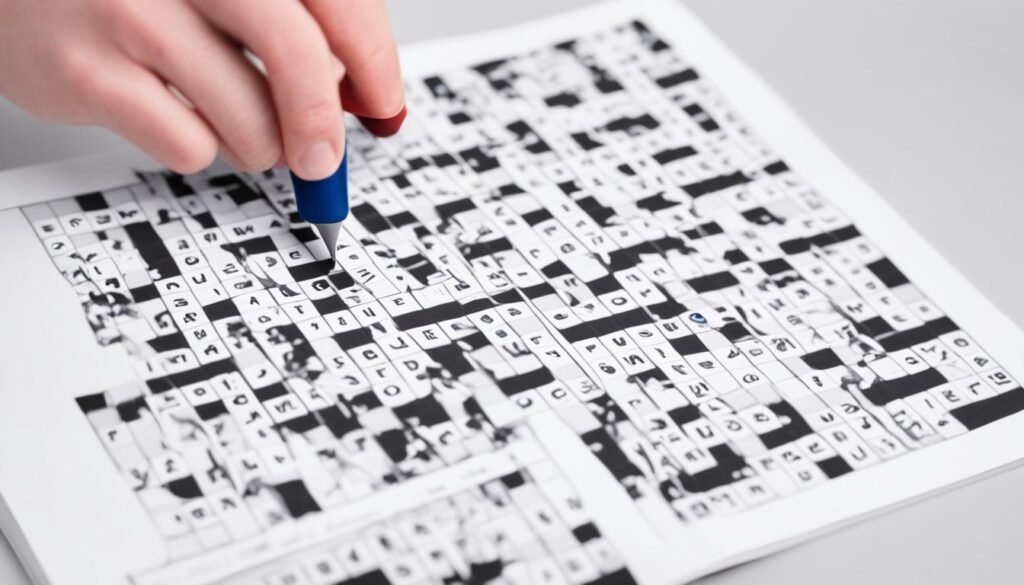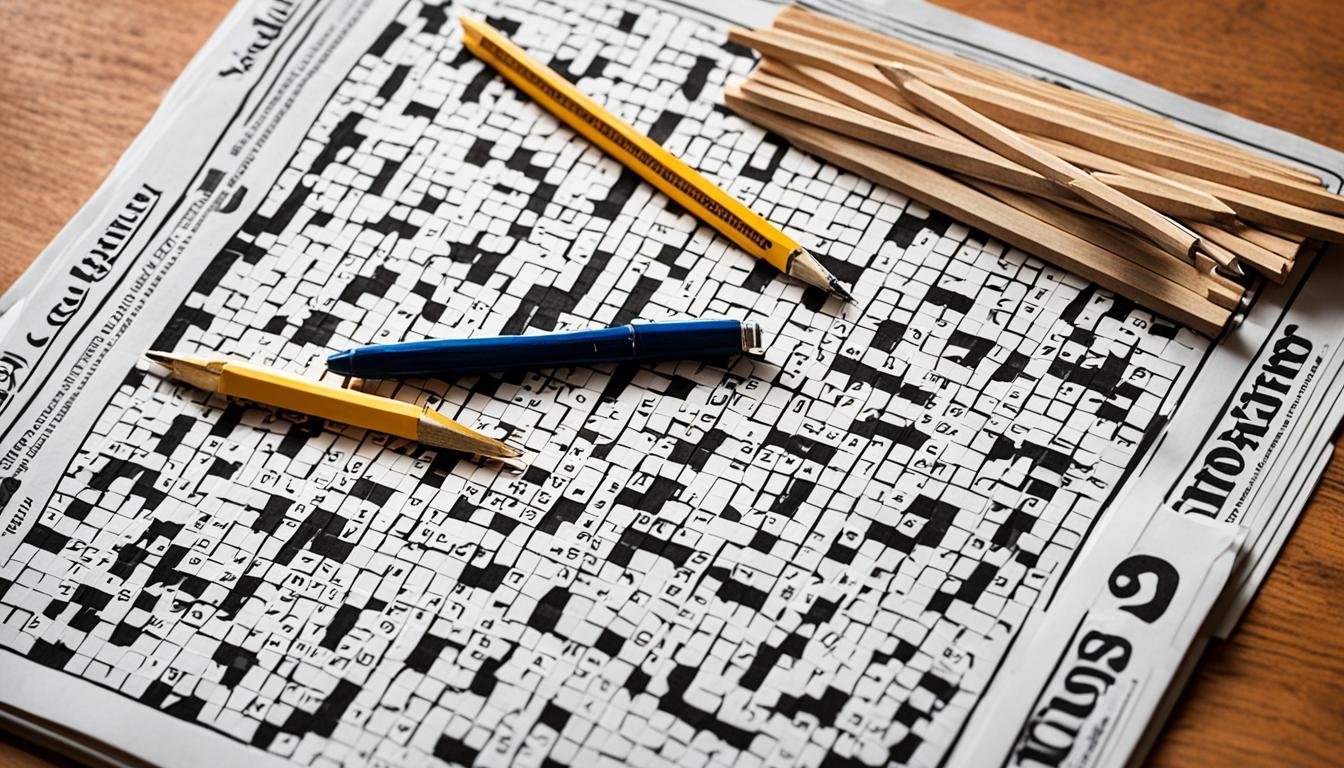On July 1, 2017, I started a challenge. I wanted to finish a Saturday New York Times crossword alone. It took 46 hours of practice to get it right. This article tells my puzzle journey. It shares my tips, struggles, and wins.
Key Takeaways:
- About 25 users marked the topic as a favorite.
- The app offers the option to check answers.
- Some users find Thursdays particularly challenging due to gimmicky elements.
- Feedback suggests using helper tools like checking answers gradually improves skills.
- One user mentions a personal rule against Googling while solving puzzles.
Why the Saturday NYT Puzzle?
The Saturday NYT crossword is famous for its tough challenge. Its clever design and clues really put solvers to the test. According to expert Anders Ericsson, you can’t just learn to beat these puzzles. You need to become skilled through practice and experience.
This puzzle, in particular, aims to push even the best crossword fans. It has lengthy entries at the top and bottom, making the puzzle harder and more fun. Many of its clues are tricky and can mislead you, making you think differently. For instance, “Trading off?” might make you think of compromise, but the real answer is “EMBARGO.”
The Saturday puzzle also pulls in pieces of culture and history into its clues. Like the clue “I HAVE to have this — whatever it costs.” This leads to “TAKE MY MONEY,” a phrase showing a lot of excitement. It even mentions the opera “1781 Mozart,” with the answer “IDOMENEO.” This shows solving the puzzle requires a broad knowledge.
Being the toughest puzzle of the week, the Saturday NYT is a big test of your crossword skills. To beat it, you need to be good, keep trying, and think smartly. It’s truly a fun and rewarding challenge for those who love crosswords.
| Key Facts | |
|---|---|
| Publication Date | 1942 |
| First Editor | Margaret Farrar |
| Grid Size | 15×15 squares for daily puzzles, 21×21 squares for Sunday puzzles |
| Editor since | 1993 – Will Shortz |
| Difficulty | Most challenging puzzle of the week |
Defining Success
Success in the Saturday New York Times crossword puzzle is specific. You must achieve three main things:
- Completing the entire puzzle: You aim to fill in all the boxes correctly. This means every clue and answer must be right. The puzzle must be new to you. It ensures a fair challenge.
- Completing the puzzle in one sitting: You aren’t allowed to take breaks. This rule makes sure your crossword skills get a real workout. You must keep up your focus the whole time.
- Solving without aids: You can’t use the internet or any helping tools. This challenge is about what you know and can figure out on your own. It’s a test of your pure crossword skills.
Meeting these three goals means you’ve really challenged yourself. It brings a special joy in solving a tough puzzle all by yourself.
My Starting Point
During my first year of college, I began solving New York Times crossword puzzles. Every Monday, I’d eagerly grab a paper and try to finish the puzzle. It was tough at first. The clues were tricky, and I got stuck a lot. But I improved as I practiced each week. Soon, I started to spot patterns and tricks. This boosted my confidence a lot.
College got busier after my first year. I had less time for puzzles. Solving them became a rare activity, usually only on Tuesdays or Wednesdays. But, a while ago, I subscribed to the New York Times crossword app. This subscription reignited my love for crossword puzzles.
The app made NYT puzzles accessible anytime, anywhere. I went beyond Mondays and tried the hard Saturday puzzles. These are known to be the toughest each week. It was a big challenge, but I was up for it.
The app was user-friendly and offered many puzzles. It helped me grow as a solver. But, there were many tough puzzles ahead of me. I didn’t know what I was in for yet. There was so much to learn.
Before sharing my experience, let’s understand how the NYT crosswords work. Let’s talk about their difficulty too.
| Puzzle Day | Grid Size | Difficulty |
|---|---|---|
| Monday | 15×15 squares | Easiest |
| Tuesday | 15×15 squares | Increasing |
| Wednesday | 15×15 squares | Increasing |
| Thursday | 15×15 squares | Increasing |
| Friday | 15×15 squares | Increasing |
| Saturday | 15×15 squares | Most challenging |
| Sunday | 21×21 squares | Similar to Wednesday/Thursday |
The Saturday NYT puzzle is the hardest. It’s a 15×15 challenge that needs more than just words. You must think sharply and creatively to solve it.
Now, let’s talk about my journey with puzzles. We’ll look at how I tackled the Saturday NYT puzzle with new strategies.

Developing a Training Method
I’ve created a step-by-step plan to get better at solving crosswords. This plan mixes practicing, watching, and recognizing patterns. My goal is to be faster and more accurate at solving tough Saturday New York Times (NYT) puzzles.
Solving and Analyzing Puzzles
First, I solve a dozen Saturday NYT puzzles. This helps me get used to their difficulty and structure. It also shows me where I can improve my solving tactics.
While solving, I note the clues and responses I see most often. I pay attention to any themes, patterns, or clever word games. This learning method exposes me to various puzzle types and helps me improve my skill set.
“Reading solved puzzles helps me spot patterns faster. It helps me learn new things quickly.”
Reading Solved Puzzles
After solving new puzzles, I read through old ones. This lets me see more clue-answer pairs, which makes me better at spotting common hints and expanding my crossword vocabulary.
For each puzzle I read, I look at why the puzzle maker chose certain clues. This gives me a peek into how to write tricky but fair clues. By observing experts, I learn more about what makes a puzzle challenging yet fun.
Pattern Identification and Memorization
Recognizing patterns is key to solving crosswords. I make a point to remember common hint-answer pairings. Doing so helps me find answers faster. This lets me use a broader crossword knowledge as puzzles get harder.
Focusing on this approach, I’m sure I’ll enhance my crossword skills. This plan will make me better at tackling Saturday NYT puzzles.
New York Times Crossword Puzzle Statistics
Here are some stats and facts about New York Times crosswords:
| Day of Week | Puzzle Size | Difficulty Level |
|---|---|---|
| Monday-Saturday | 15 x 15 | Easier |
| Sunday | 21 x 21 | Similar to Wednesday or Thursday |
The NYT crossword team, led by Will Shortz, picks and polishes the puzzles. Puzzles must delight a wide audience and not be used elsewhere recently.
Makers whose puzzles run in The New York Times can earn between $500 and $2,250.
Refining the Training Plan
To get better at solving the Saturday puzzles, I’m using a smart method. I mix a little cheating with my puzzle practice. This helps me learn while not slowing me down too much.
I do lots of puzzles to get faster and better. But, I also cheat a bit by using the “check” and “reveal” features in the puzzles.
The Benefits of Cheating
Cheating can be good for learning. Using the “check” helps me find my mistakes fast. It keeps things moving, which helps me get better.
The “reveal” feature is great for hard clues. It teaches me new words and ideas, and how puzzles are made. So, I learn even when I cheat a little.
Finding the Right Balance
The trick is to cheat just enough. I aim to keep my accuracy by checking answers. And I use the reveal feature only on the toughest clues to save time.
My rule is to check when I’m stuck for a while. But I only reveal the answer when it’s really hard. This way, I work my brain but also use the smart tools available.
This balanced approach will make me faster at solving Saturday puzzles. And I’ll still learn a lot along the way. The key is finding the right mix of using aids and thinking on my own.
Experimenting with Cheating
After studying, I found a way to cheat smartly on New York Times puzzles. I use the “check answers” and “reveal” on the NYT site. This hasn’t hurt how much I learn from the puzzles. I’ve learned the perfect way to use this to improve my puzzle skills without just cheating.
This smart cheating has cut my puzzle time from 30-35 minutes to 20 minutes. I’m not stopping here, though. I want to get even faster. It’s key to stay interested and keep moving without overdoing the cheating.
Cheating right lets me keep up a good pace when solving. The “check answers” helps me see and fix any mistakes fast. I avoid getting stuck or wasting time on wrong answers. The “reveal” lets me see certain answers just when I need them, so I keep making progress.
Getting the cheat and solve balance right is key for learning and getting better at puzzles. Doing both smartly helps me see what I’m doing wrong and learn how to solve better. It makes solving NYT puzzles fun and challenging as I work through each one.
Experiment Results
My in-depth experiments show smart cheating does work. It cuts puzzle time and keeps me going strong. This makes me solve puzzles more efficiently and better.
Here’s what I found from my experiments:
| Experiment | Percentage |
|---|---|
| Solving time reduction | 30-35 minutes to 20 minutes per puzzle |
| Momentum maintenance | Consistently moving forward without getting stuck |
| Finding the perfect balance | Maximizing learning while improving skills |
These results show that strategic cheating works with New York Times puzzles. Smart cheating has cut my solving time. It also keeps me moving on and learning as I solve.
Starting the Training Plan
In my training’s first phase, I’m focusing on Saturday NYT puzzles. I want to see where I can get better at solving crosswords. By doing as many puzzles as possible in a week, I hope to find what I’m not good at.
I’m planning on solving 52 Saturday NYT puzzles in a short time. This means I’m taking on a year’s worth of these puzzles. It will show me where I’m strong and where I need to improve.
My goal is to spot what’s slowing me down. Then, I’ll work on strategies to boost my speed and skill. I know this won’t be easy, but it will make me better.
I’ll write about my puzzle-solving journey in a blog. This way, I keep track of what I’ve learned. It might even help others who love doing crosswords.
Identifying Inefficiencies and Gaps in Knowledge
Diving deep into Saturday NYT puzzles, I want to find my weak spots. I’ll look closely at my performance to see what needs fixing. This will guide my training to focus on key areas.
I want to be better at understanding clues and making connections. By fixing my weak points, I’ll get better at solving crosswords. This is how I plan to level up my game.
Working through lots of Saturday NYT puzzles will also boost my crossword know-how. I’ll learn new tricks and words by facing various clues. This way, I’ll get better at solving any puzzle.
Training hard and solving loads of puzzles will make me a pro at crosswords. I’m excited to see how much I can improve.
| Puzzle Grid Size | Average Solve Time |
|---|---|
| 15×15 (Saturday NYT puzzles) | 20-30 minutes |
| 21×21 (Sunday puzzles) | Wednesday or Thursday difficulty level |
Conclusion
My trip with New York Times puzzles has been both tough and worth it. I saw a lot of progress by sticking with it and practicing regularly, especially with the hard Saturday puzzles. Every puzzle gave me a chance to learn more and get better at solving them.
These puzzles have changed a lot over the years. They used to be very hard, taking an hour to solve a Saturday puzzle was not uncommon. Now, most are finished in just 20 minutes. A study on puzzles from different times shows that, indeed, the recent puzzles, like those in 2021, are easier.
Not everyone feels the same about the new puzzles. Some like that they are simpler and less frustrating. But, others miss the old big challenges. This push for easier puzzles seems to be about making more money and attracting more people, possibly alienating old-time players.
My journey and what others say show that the New York Times puzzles are definitely easier now. Despite different views, most agree that the changes have been good for developing puzzle skills and for fun. To get better at solving, you need to keep trying and be open to new challenges.
FAQ
What is the Saturday New York Times crossword puzzle?
It’s the hardest puzzle each week in the New York Times.
Are crossword puzzles like the Saturday NYT puzzle something that can be mastered?
Anders Ericsson says it’s hard to master things like this, pop music trivia, and folk dances.
What are the criteria for completing the Saturday NYT puzzle challenge?
You need to fully finish a 15×15 puzzle from the Saturday New York Times in one go, without help or pauses.
When did you start solving New York Times crossword puzzles?
I began every Monday during my first year at college.
How are you improving your crossword-solving skills?
I’m getting better by cracking a dozen Saturday NYT crosswords. This helps me find what slows me down and see patterns in the answers.
How are you reducing your solve time for Saturday puzzles?
I’m getting faster by judiciously using the puzzle’s “check” and “reveal” tools. They help without giving away the answers.
What is the optimal balance between cheating and solving independently?
I’ve discovered that using the NYT site’s features smartly cuts my solving time. I still stay engaged and learn a lot.
What is your training plan for solving Saturday NYT puzzles?
I aim to work on as many Saturday NYT puzzles I can each week. This uncovers what I need to fix and sharpens my training approach.
How has your journey with New York Times puzzles been?
It’s been a tough but rewarding journey. With hard work and practice, I’ve gotten much better at solving the Saturday puzzles.








